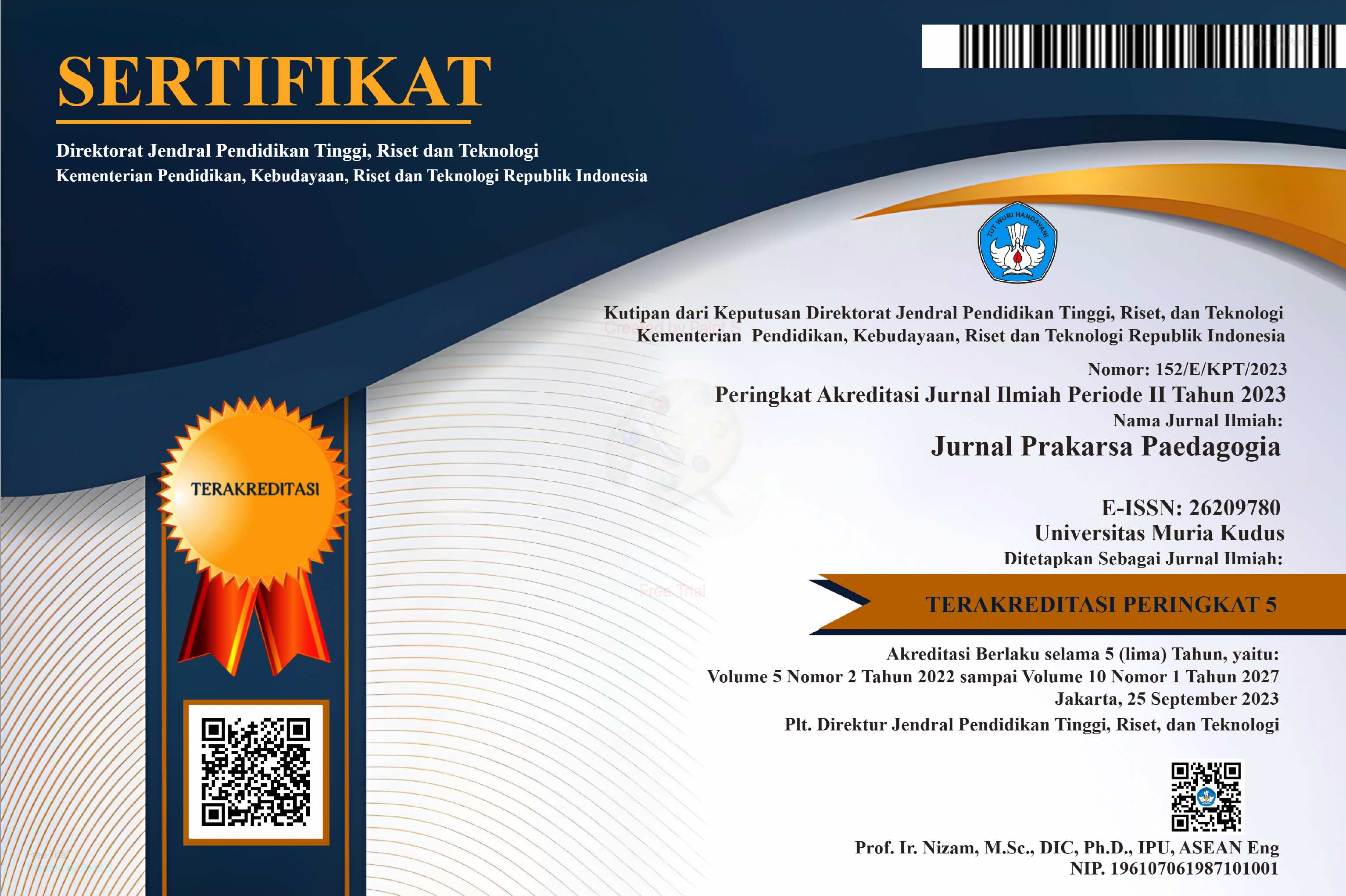Embracing Students’ Self Confidence: Bringing Instagram Into English Speaking Classroom, Why Not?
Abstract
Full Text:
304-314 (Bahasa Indonesia)References
Aftat, M. (2008). Motivation and genuine learning. http://www.englishteacher1.com/motivation.html
Alassiri, A. A., Muda, M. B., & Ghazali, R. Bin. (2014). Usage of Social Networking Sites and Technological Impact on the InteractionEnabling Features. International Journal of Humanities and Social Science, 4, No. 4(Special Issue February). http://www.ijhssnet.com/journals/Vol_4_No_4_Special_Issue_February_2014/6.pdf
Bailey, K. M. (2005). Practical English language teaching:Speaking. McGraw Hill.
Belal, A. (2014). Influence Of Digital Social Media In Writing And Speaking Of Tertiary Level Student (Master thesis, BRAC University, Dhaka, Bangladesh) [BRAC University]. http://dspace.bracu.ac.bd/xmlui/bitstream/handle/10361/5557/12263005.pdf?sequence=1&isAllowed=y
Brown, H. D. (2001). Teaching by Principle: An Interactive Approach to Language Pedagogy. Longman.
Brown, H. D. (2010). Language Assessment: Principles and Classroom Practices (2nd Edition) (2nd ed.). Pearson Longman.
Byrne, D. (1997). Teaching Oral English. Longman Limited.
Chaney, A. L., & Burk, T. L. (1998). Teaching Oral Communication in Grades K-8. Allyn and Bacon.
Cohen, A. D. (1994). Assessing Language Ability in the Classroom (2nd ed.). Heinle & Heinle.
Crystal, D. (2003). The Cambridge Encyclopedia of the English Language (2nd ed.) Cambridge: Cambridge University Press.
Dinkelman, T. (1997). The Promise Of Action Research For Critically Reflective Teacher Education. The Teacher Educator, 32(4), 250-274. http://dx.doi.org/10.1080/08878739709555151
Gebhard, J. G. (1996). Teaching English as a Foreign or Second Language: A Teacher Self-Development and Methodology Guide. University of Michigan Press.
Gremu, C. D. (2012). The Educational Value of Integrating a Social Networking Platform and a Learning Management System [Rhodes University]. https://www.cs.ru.ac.za/research/g12g1792/documents/thesis.pdf
Handayani, F. (2016). Instagram As A Teaching Tool? Really? Proceedings of the Fourth International Seminar OnEnglish Language and Teaching (ISELT-4). http://ejournal.unp.ac.id/index.php/selt/article/download/6942/5476
Hensen, K. T. (1996). Teachers as researchers. In J. Sikula (Ed.), Handbook of research on teacher education (4th ed., pp. 53-66). New York: Macmillan.
He, S. X., & Chen, A. J. . (2010). How to Improve Spoken English. https://sites.google.com/site/languagejournal/Home/how-to-improve-spoken-english
Hughes, A. (2003). Testing for Language Teachers. Cambridge University Press.
Iwashita, N., Brown, A., McNamara, T., & O’Hagan, S. (2008). Assessed levels of second language speaking proficiency: How distinct? Applied Linguistics, 29(1), 24–49. https://doi.org/https://doi.org/10.1093/applin/amm017
Johnson, A. P. (2012). A short guide to action research (4th ed.). New Jersey: Pearson Education.
Joshi, A., Kale, S., Chandel, S., Pal, D. K. (2015). Likert Scale: Explored and Explained. British Journal of Applied Science & Technology, 7(4): 396-403. doi: 10.9734/BJAST/2015/14975
Juhana. (2011). INVESTIGATING THE DIFFICULTIES ENCOUNTERED BY STUDENTS IN PRACTICING SPEAKING IN ENGLISH CLASS”. A Case Study at a Senior High School in South Tangerang, Banten. Universitas Pendidikan Indonesia.
Khalitova, L., & Gimaletdinova, G. (2016). MOBILE TECHNOLOGIES IN TEACHING ENGLISH AS A FOREIGN LANGUAGE IN HIGHER EDUCATION: A CASE STUDY OF USING MOBILE APPLICATION INSTAGRAM. ICERI2016 Proceedings 9th International Conference of Education, Research and Innovation November 14th-16th, 2016. https://www.researchgate.net/profile/Liliia-Khalitova/publication/305770116_Instagram_Mobile_Application_in_Teaching_EFL_at_University_level/links/592400a8a6fdcc4443fac81d/Instagram-Mobile-Application-in-Teaching-EFL-at-University-level.pdf
Kompas. (2017). Indonesia, Pengguna Instagram Terbesar Se-Asia Pasifik. http://tekno.kompas.com/read/2017/07/27/11480087/indonesia-pengguna-instagram-terbesar-se-asia-pasifik
Kukurs, R. (2010). Conquer Your Fear of Making Mistakes when Speaking English! http://englishharmony.com/conquer-fear-of-making-mistakes-when-speaking-english/
Kurtus, R. (2019). Overcome the Fear of Speaking to Groups. https://www.school-for-champions.com/speaking/fear.htm
Magiono. (2007). Improving the Students’ Speaking Skill through Debate at the Third Year of the Accounting 2 of SMKN 1 Banyuwangi. Islamic University of Malang.
McNiff, J., Lomax, P. & Whitehead, J. (1996). You and your action research project. New York: Routledge.
McTaggart, R. (1997). Reading the collection. In R. McTaggart (Ed.), Participatory action research (pp. 1-12). Albany, NY: SUNY Press.
Mills, G. E. (2011). Action research: A guide for the teacher researcher (4th ed.). Boston: Pearson.
Nunan, D. (1999). Second language teaching & learning. Heinle & Heinle Publishers.
Nurkasih, S. (2010). Improving students’ speaking skill through communicative group technique. Universitas Sebelas Maret.
Pawlak, M., Waniek-Klimczak, E., & Majer, J. (2011). Speaking and Instructed Foreign Language Acquisition. Multilingual Matters.
Saurik. (2011). Learning English The Easy way! http://guides.wikinut.com/Learning-English-The-Easy-Way!/2wuchx26/
Soheil, M. & Asgar, M. (2015). Internal and External Factors Affecting Learning English as a Foreign Language. International Journal of Language and Linguistics. Vol. 3, No. 5, 2015, pp.313-322. doi: 10.11648/j.ijll.20150305.16
Stringer, E. T. (2008). Action research in education (2nd ed.). New Jersey: Pearson.
Tyson, J. (2009). Connecting Through Facebook: The Influence of Social Networking on Communication [Wake Forest University]. https://wakespace.lib.wfu.edu/bitstream/handle/10339/14774/jtyson_Thesis.pdf
Underwood, M. (1996). Teaching Listening. Longman Inc.
Weir, C. J. (1993). Understanding and Developing Language Tests. Prentice Hall Books.
Yi Htwe Yi. (2007). Shyness Main Obstacle To Learning English. http://www.mmtimes.com/no371/n010.htm
DOI: https://doi.org/10.24176/jpp.v4i2.7253
Refbacks
- There are currently no refbacks.
Copyright (c) 2022 Jurnal Prakarsa Paedagogia

This work is licensed under a Creative Commons Attribution-NonCommercial-ShareAlike 4.0 International License.
Visitors of the Paedagogia Prakarsa Journal Status
Country of Origin of Visitors:
Jurnal Prakarsa Paedagogia dari Fakultas Keguruan dan Ilmu Pendidikan Universitas Muria Kudus is licensed under a Creative Commons Attribution 4.0 International License.
Dedicated to:







